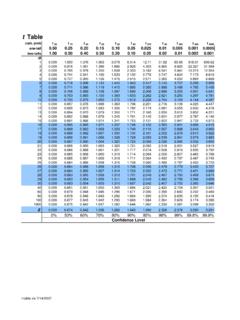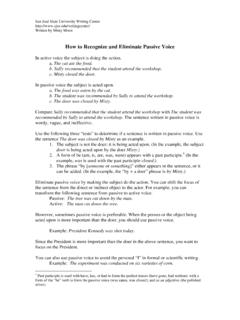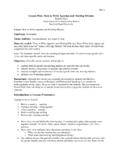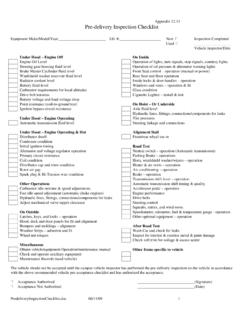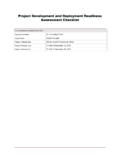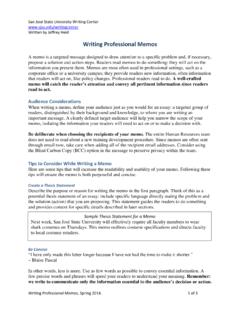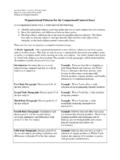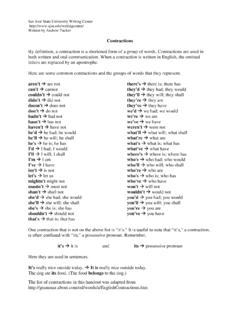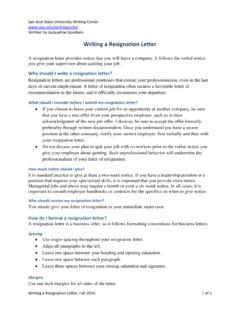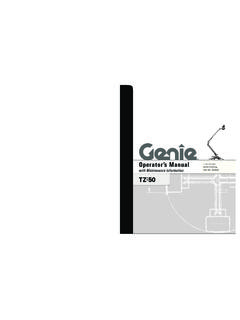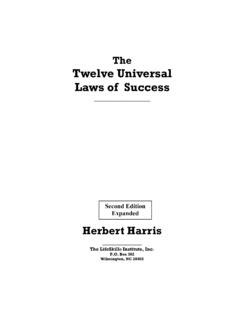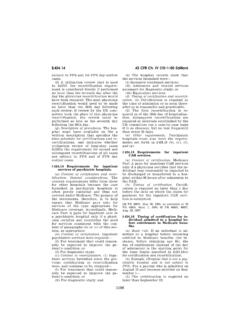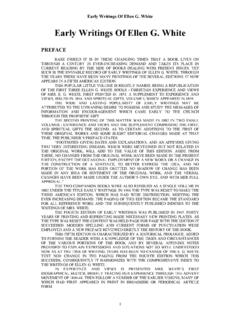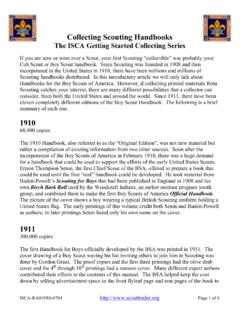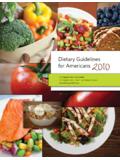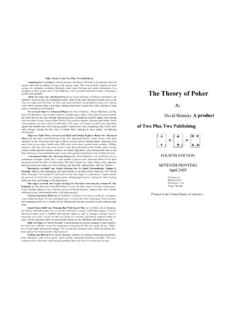Transcription of GUIDELINES FOR AUTHORS OF MANUSCRIPTS THE …
1 GUIDELINES FOR AUTHORS OF MANUSCRIPTS THE GEOLOGICAL SOCIETY OF AMERICA BULLETIN (12 June 2003) Contents PREPARATION OF PAPERS Text Organization Resources for Writing Tools for Writing Word Processors, Font Parts of the Text Tables Tools for Composition Word Processors, Font Table Structure Figures General GUIDELINES for All Figures Hand Drafting and Photography Graphics Software Maps, Shaded Figures, and Charts Sizing Figures Figures with Multiple Parts Color Abridged from Geological Society of America Website: PREPARATION OF PAPERS Text MANUSCRIPTS must correctly use approved geological and other scientific terminology and have no grammar or spelling errors; GSA ensures that this goal is achieved by copyediting every manuscript. You must also check your manuscript for accuracy and consistency in use of capitalization, abbreviations, and dates. You must also cross check your manuscript's citations with your manuscript's reference list. Use GSA style for the references in the reference list (examples follow later in these GUIDELINES ).
2 Organization Define precisely the contribution at the outset and present it clearly in the fewest words possible (but avoid jargon and telegraphic phrasing that make it meaningful to only those few studying the same specialty) so that the reader may get a maximum of facts and ideas from a minimum of text. State the purpose, give a minimum of background, concisely present the data that led to the conclusions, clearly differentiate fact and inference, and 2 present justifiable conclusions and, perhaps, further implications of the conclusions. Assume that your readers are familiar with the general literature and need not be told basic principles; therefore, give only the background and reference material necessary to support the arguments. Provide only brief descriptions of methods and laboratory techniques (preferably as an Appendix). Do not describe standard methods in detail if references to the methods can be cited. Resources for Writing Spelling.
3 Bulletin uses American English. Our primary guide for spelling is the 10th edition of Merriam-Webster's Collegiate Dictionary (1993), which can be accessed on the web ( ). For technical words not contained in this resource, we use the current edition of the Glossary of Geology, published by the American Geological Institute ( ). Composition Style. With only a few exceptions (most notably, in the reference lists), Bulletin follows the style outlined in the 14th edition of the Chicago Manual of Style (1993), published by the University of Chicago Press ( ). Capitalization. Our primary guide for capitalization of common words is the 10th edition of Merriam-Webster's Collegiate Dictionary (1993), which can be accessed on the web ( ). We also use the 14th edition of the Chicago Manual of Style (1993), published by the University of Chicago Press ( ). For technical words not contained in this resource, we use the GUIDELINES contained in the seventh edition of Suggestions to AUTHORS of the Reports of the United States Geological Survey (1991), published by the Government Printing Office.
4 Abbreviations. Abbreviations should be used only when necessary and should be legitimate abbreviations in use in the scientific community. Never coin abbreviations to take the place of names ( , using BRP in place of Basin and Range province is not acceptable). If you use abbreviations that are likely to be known only to members of a particular discipline ( , abbreviations for mineral names), please add a table of abbreviations and their explanations to your manuscript. Units of Measure. Use the International System of units (SI, or metric) in captions, illustrations, and text. Measurements in non-SI units may be necessary in some circumstances, such as elevation measurements in the text that correlate to topographic maps, or because of the intended readership. In such cases, you should provide SI measurements first, which should be followed by the non-SI equivalents in parentheses. Mathematical Expressions. Our primary guide for the treatment of mathematical expressions and equations is the current edition (1999) of Mathematics into Type, published by the American Mathematical Association.
5 All variables (except vectors) should be italicized; only labels (usually as subscripts) that are themselves variables should be italicized, , Xmin or Xa, but Xi or CP (underlining here is merely to emphasize where italics are applied). Mathematical functions (such as log or tan) and chemical 3 symbols should not be italicized. If you are using Word Equation Editor for a displayed equation or complex within-text term, define the labels that are not variables as "text" style to eliminate the default italics. Define all mathematical symbols in the text the first time each appears. Equations should be set off from the rest of the text by line spaces above and below. Equations should be numbered sequentially only if they are cited in the text; the numbers should be enclosed in parentheses and set to the right of the equations. Citation of Unpublished Material. Citations of unpublished material can be problematic. Following are the six main categories of such items and the manner in which each should be handled.
6 In preparing references such as these, use GSA style as described subsequently in this document. (1) Citations of theses and dissertations, which are usually unpublished, are always permitted. (2) Without exception, citations of unpublished MANUSCRIPTS that have not been accepted for publication are not permitted. Substitute a dated personal communication or a citation to a published reference. At the last minute, you may add your preferred citation if the item has been accepted for publication during review and editing of your manuscript. (3) Citations of unpublished personal data (field data, mapping, etc.) that belong to one of the AUTHORS should be deleted. Incorporate the data in the paper, or make it available in the GSA Data Repository. (4) Citations of unpublished personal data (field data, mapping, etc.) that belong to someone other than one of the AUTHORS should also be deleted. Instead, secure permission from the owner of the data to use the data, or refer to the data in general terms by using only a dated personal communication.
7 (5) Citations of open-file reports and other unpublished works from various government agencies (often called gray literature) are permitted. (6) Citations of company reports and the use and interpretation of proprietary industry data are permitted, even if these items are not available to the reader. If they are available (either in libraries or from the company), this should be noted for the benefit of the reader. Other Resources. Use the current edition of the North American Stratigraphic Code (1983), which is available online ( ), for proper usage and capitalization of stratigraphic terminology and concepts. Use GEOLEX, which is avilable online ( ), for checking spelling and captialization of geologic names in the Geological Survey database. Use other official resources that define proper approaches to the use of technical terminology. Abstract. The abstract should present information and results in capsule form and should be brief and objective, containing within a 150-word maximum the content and conclusions of the paper.
8 The topic sentence should give the overall scope and should be followed by emphasis on new information. Omit references, criticisms, drawings, and diagrams. Body of the Text. Precisely define the contribution at the outset and present it clearly in the fewest words possible (but avoid jargon and telegraphic phrasing that is meaningful 4 only to those few studying the same specialty), so that the reader may get a maximum of facts and ideas in a minimum of time. State the purpose, give a minimum of background, concisely present the data that led to the conclusions, clearly differentiate fact and inference, and present justifiable conclusions and, perhaps, further implications of the conclusions. Assume that your readers are familiar with the general literature and need not be told basic principles; therefore, give only minimal background and reference material. Provide only brief descriptions of methods and laboratory techniques (preferably as an Appendix).
9 Do not describe standard methods in detail if references to the methods can be cited. Include footnotes and citations of figures and tables in appropriate places. The body should be divided by using no more than four levels of headings (not including title of paper). These headings have rigid typographical definitions, as follows: First-level headings: Bold, all caps, flush left on separate line. Second-level headings: Bold, initial caps, flush left on separate line. Third-level headings: Bold italics, initial caps, flush left on separate line. Fourth-level headings: Bold italics, sentence capitalization, set at the beginning of a paragraph of text with a period. No other headings or styles are possible. The first citation of each figure and of each table must be sequential and must use simple numerals ( , Fig. 1, Table 1). The words "Figure" and "Figures" should be capitalized; they should be abbreviated (to Fig. and Figs.) when enclosed in parentheses.
10 Footnotes. Avoid most footnotes and parenthetical statements. Textual footnotes that are deemed necessary should be numbered consecutively with superscripts. Appendix. The Appendix is optional and contains brief descriptions of methods, laboratory techniques, and other supplementary information. Title all appendixes (for example, APPENDIX 1. SAMPLE DESCRIPTIONS); number appendixes only if there are two or more. If more than one level of heading is required, use the same style as that used in the body of the text. Place appendixes at the end of the text before the Acknowledgments. Do not place appendixes in the Data Repository. Number tables and 5 figures in the Appendix separately from the text ( , Fig. A1, Fig. A2, Table A1, etc.). References Cited. All references mentioned in the text, figures, captions, tables, and appendixes must be listed in the References Cited section. Only references cited in the paper are to be listed. The reference list for your Data Repository material should be separate and complete (do not omit references also cited in the paper itself) and placed in the Data Repository.

